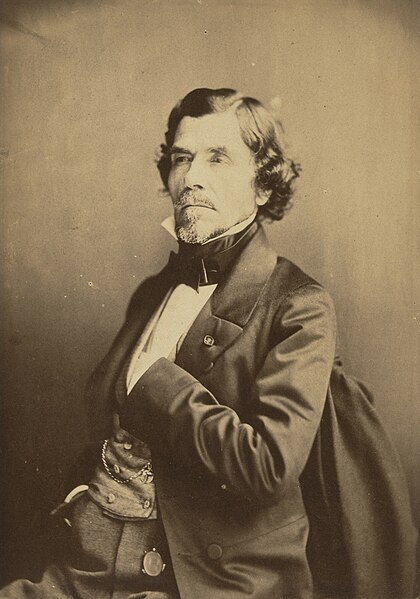
Born: 26 April 1798, Charenton-Saint-Maurice
Died: 13 August 1863 (aged 65)
Period: Romanticism
The Life of Eugene Delacroix
Eugène Delacroix was a towering figure in 19th-century French art, known for his leading role in the Romantic movement. His work is characterized by its dramatic and expressive use of color, movement, and brushstroke, which broke away from the precise and orderly nature of Neoclassicism and paved the way for the Impressionist and Symbolist movements.
Born in Charenton-Saint-Maurice, France, Delacroix was educated at the Lycée Louis-le-Grand and later attended the École des Beaux-Arts in Paris. He was deeply influenced by the work of previous masters such as Rubens and the Venetian Renaissance artists, as well as by contemporary events and Eastern cultures, which he encountered during a diplomatic mission to Morocco in 1832. This trip, in particular, had a profound impact on his use of color and his subject matter, introducing a fascination with the exotic that would feature prominently in his work.
Delacroix’s first major success came with “Dante and Virgil in Hell” (1822), which was exhibited at the Salon of 1822 and marked the beginning of his recognition as a leading painter of the Romantic movement. However, it was “Liberty Leading the People” (1830), commemorating the July Revolution of 1830, that became one of his most iconic works, celebrated for its dynamic composition, vivid emotion, and powerful symbolism.
Throughout his career, Delacroix produced an extensive body of work, including paintings, murals, and lithographs, that explored themes of violence, passion, and the sublime. His murals for the Saint-Sulpice church in Paris are among his most significant achievements in public art, demonstrating his mastery of large-scale compositions and his ability to convey profound spiritual and historical narratives.
Delacroix’s approach to painting, with its emphasis on color and movement, was highly influential for the generations of artists that followed. Although he was somewhat isolated from other artistic movements of his time, his work had a lasting impact on the development of modern art. Figures such as Cézanne and Van Gogh admired and were influenced by Delacroix’s use of color and expressive brushwork.
Eugène Delacroix passed away in Paris in 1863, leaving behind a legacy that cemented his status as a pivotal figure in the transition from the classical traditions of the past to the modern art of the future. His passionate and innovative approach to painting continues to be celebrated for its emotional power and artistic daring.
Eugene Delacroix’s Notable Works
Eugène Delacroix was renowned for his dramatic and emotive works that broke away from the strictures of Neoclassicism and paved the way for the Romantic movement. His masterful use of color and bold brushwork would later influence the Impressionists and Symbolists, marking him as a pivotal figure in the transition to modern art. Here are ten of Delacroix’s most famous and influential works:
- Liberty Leading the People (1830) – Perhaps Delacroix’s most iconic painting, it commemorates the July Revolution of 1830 in France. The allegorical figure of Liberty guides the people forward over the bodies of the fallen, symbolizing the struggle for freedom.
- The Death of Sardanapalus (1827) – Inspired by the tale of the Assyrian king Sardanapalus, this work is a dramatic and opulent depiction of the king’s last moments, showcasing Delacroix’s flair for drama and color.
- The Massacre at Chios (1824) – Early in his career, Delacroix created this harrowing depiction of the massacre of the Greek islanders of Chios by Ottoman troops, highlighting his sympathy for the Greek cause in the Greek War of Independence.
- Women of Algiers in their Apartment (1834) – After his trip to North Africa, Delacroix painted this intimate scene of Algerian women in their private quarters, celebrated for its detailed portrayal of Islamic culture and masterful use of color.
- The Barque of Dante (1822) – Also known as “Dante and Virgil in Hell,” this painting was inspired by Dante Alighieri’s “Inferno” and shows the poets crossing the Styx. It established Delacroix’s reputation at the Salon.
- Christ on the Sea of Galilee (1854) – This painting depicts Jesus calming the storm on the Sea of Galilee, showcasing Delacroix’s ability to convey biblical themes with emotional depth and dynamic composition.
- The Battle of Nancy (1831) – Commissioned for the Museum of French History, this painting celebrates the victory of Duke René II of Lorraine over Charles the Bold of Burgundy in 1477, demonstrating Delacroix’s skill in historical painting.
- Moroccan Chieftain Receiving Tribute (1837) – Another result of his North African travels, this painting reflects Delacroix’s fascination with exotic themes and his ability to capture the vibrancy of Moroccan life and attire.
- Entry of the Crusaders into Constantinople (1840) – Part of a series for the Paris Palais Bourbon, this epic canvas depicts the Fourth Crusade’s sack of Constantinople, highlighting Delacroix’s interest in dramatic historical episodes.
- Medea about to Kill her Children (1838) – This work captures the tragic moment from Greek mythology when Medea decides to kill her children to avenge her betrayal by Jason, showcasing Delacroix’s mastery of psychological drama and intensity.
Eugène Delacroix’s work is characterized by its emotional power, innovative use of color, and dramatic themes, which left a lasting impact on the development of Romanticism and the course of Western art.